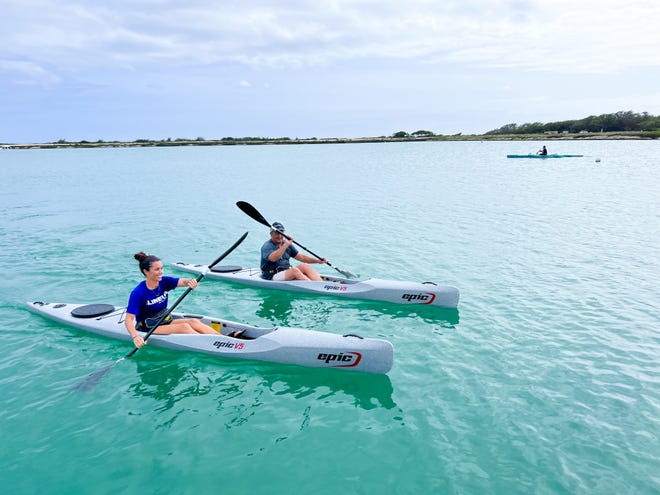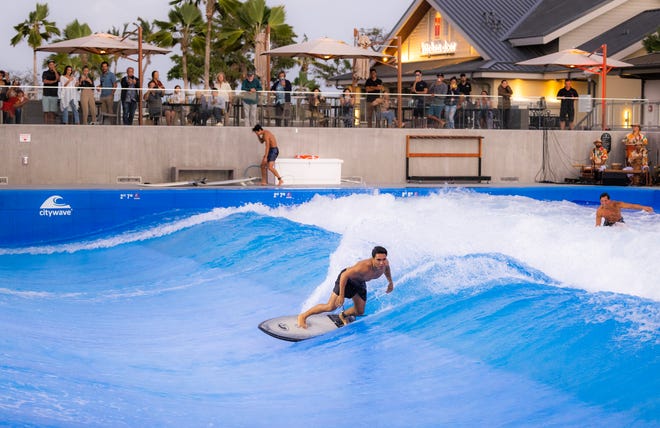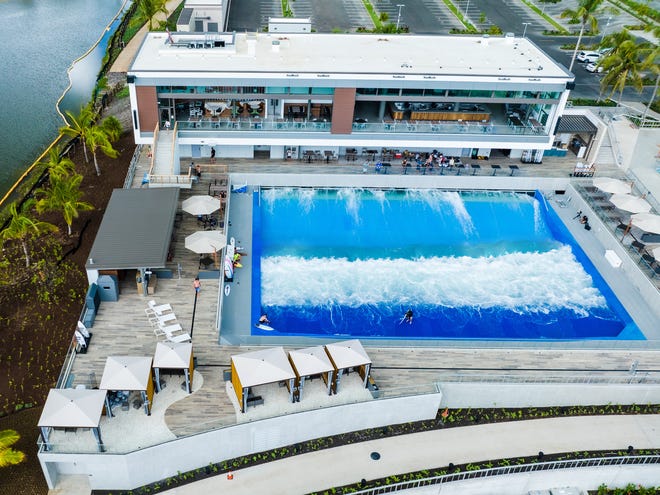https://www.usatoday.com/story/travel/2023/04/12/hawaii-wave-pool-wai-kai-oahu/11594808002/
|
Why the opening of the world's largest standing wave pool is a 'touchy situation' in Hawaii
 Kathleen Wong
Kathleen WongTo say that surfing has deep roots in Hawaii is an understatement.
Historians believe modern surfing, or people standing on a wooden board while riding a wave, was born on the islands. Everyone, including men, women, children, royalty and common folks, all played on nalu, or waves, on surfboards. European colonizers to Hawaii noted surfing as far back as the 1800s.
Today, the world's best surfers dream of going to Hawaii to ride legendary waves such as Pipeline, Waimea Bay, or Waikiki.
Now on Oahu, there's another, very different wave for surfers.
Hawaii opened its first wave pool on March 25: the LineUp at Wai Kai – wai meaning water and kai meaning sea in Hawaiian – as part of a recreational area located on the west side of Oahu. In the 100-foot wide wave pool, you can forget about the wind, tide, or swell conditions – or reading the lineup among the other surfers. You don't even need to paddle to catch a wave.
Sustainable Hawaii tourism:What it's like to stay at Kauai's first zero-waste hotel
Is it expensive to island hop in Hawaii? Here's how to save money and fly between islands
"We envision Wai Kai as a place where travelers can come and experience the island through the eyes of a local," Skip Taylor from Surf Park Management, which manages the wave pool, told USA TODAY. "Visitors can surf, paddle, eat and relax while interacting with the local community. Our goal is to provide an authentic connection to the modern Hawaiian lifestyle."
Wai Kai aims to complement Hawaii's "waterman" lifestyle – where one lives and breathes the ocean – and be a community-gathering space.
As the world's largest deep-water standing surf wave, the pool has also drawn controversy for being built during a drinking water crisis among residents and mere feet away from Hawaii's world-class ocean. (Seriously, you can see two surf spots, White Plains and Hau Bush right past the fencing.)
"For too long, too many of us have forgotten the fundamental understanding in Hawaii that water is a precious and limited resource, a gift that must be protected and used for the good of the community rather than private, corporate gain," said Wayne Tanaka, director of the Sierra Club of Hawaii, who has led legal actions against the water crisis and spoken out against the wave pool.
ChangingEwa Beach
It's not just the wave pool that's new to Oahu's Ewa Beach community, known as a quieter part of the island that's faced rapid development over the past few decades. The Hoakalei Resort, home to the wave pool, is envisioned as a "vibrant and exciting waterfront resort destination and community," according to developer Haseko's website.
Within the past decade, 9 acres have been developed for commercial and residential use. As of April 6, 75% of Wai Kai's staff are Ewa Beach residents.
Second-generation Ewa Beach resident Kanani Langley, who owns a small business called Hau Bush Board Co., said the Wai Kai development "doesn't sit right" with him. His big concern is the development attracting too many tourists into the area, causing traffic and crowds.
'It's like your local bestie':This startup helps make solo travel as a woman feel safer
Don't be that tourist:Here's how to respectfully visit Hawaii, have an authentic trip
"When all the hype dies down with the locals, that's what we're afraid of, (Wai Kai) will have to cater to somebody else, the tourists, and they're gonna discover a beach over here and make it worse for our beaches," he said. "It's a touchy situation."
The largest part of Wai Kai, the 52-acre-large lagoon – dug and then filled naturally by an aquifer – has a contentious history. In 1990, plans were approved for the lagoon to become a marina, but that idea was scrapped in 2011 – to the dismay of some homeowners, who filed a class-action lawsuit calling the development company "deceptive." The company was ordered to pay up $20 million in 2018.

"After speaking with the hotel industry, waterfront designers and others, it became clear that making a course change would better serve both the company and community," said Craig McGinnis, Chief Operating Officer, Haseko in Hawaii. "Transforming the marina into a lagoon enables us to realize our vision of a dynamic waterfront community in a more timely and efficient manner that more people will enjoy."
The lagoon is only accessible by Wai Kai guests, but a corner is slated to be roped off for the public, Taylor said.
What is it like at the wave pool?
"We weren't trying to recreate the ocean," Taylor said. Ocean surfers will find that out quickly. Built by a company called Citywave, the wave pool is closer to river surfing, like at Waimea River, than ocean surfing. Pumps create a nonstop wave that can be adjusted to different heights and volumes.
The pool is open at its entire 100 feet and allows a maximum of 10 surfers during a 45-minute session. In the future, it will be split up into two or three sections, allowing even more people in one session. Surfers can sign up online for sessions throughout the day.
Pros of riding the wave pool:
- All levels are welcome to ride the wave. Pro surfers such as Olympic gold medalist Carissa Moore and legendary surfer Gerry Lopez have ridden the wave. On an overcast Sunday afternoon, a first-time surfer managed to balance his way across the entire pool, and said he wanted to do it "over and over again."
- There's no paddling into the wave – there's a sort of unofficial promise that you can ride a shortboard with little to no experience because of that. In the ocean, beginners start on a bigger board and it can take a while to get down to a shortboard.
- When it's your turn to ride the wave, it's all yours. Surfing in the real world is intimidating, especially for beginners. There's an entire lineup etiquette that can be hard to navigate, and friendliness varies from break to break. If you drop in or catch a wave that someone's already on at one break, you risk getting yelled at. It's not uncommon to witness a fight break out in the water.
- Almost always perfect conditions in a controlled environment.
Cons of riding the wave pool:
- It feels much different than riding a wave in the ocean and will take a few wipeouts to get used to.
- When you wipe out, you get thrown over the back of the wave, which was a bit brutal. My neck was sore the next morning.
- Staff routinely warn people to put their arms over their heads to protect themselves in case their boards fly into them, which should be done when surfing in the ocean anyway. During my session, one surfer's board ricocheted back at him, giving him a bloody mouth and a lost tooth. Helmets are available for free – and encouraged.
- Pricey for how fast the session is, but you will likely get five to 10 waves depending on the surfers you're with.

Hawaiian surfer Keala Tomoda-Bannert is one of the pro surfers who tried out the wave as soon as it opened to the public. The Kauai-born surfer has previously surfed other artificial waves as part of her practice. "I think it’s a good addition to Hawaii because, yes, we have incredible surf breaks, but we do have a lot of small or flat days," she said. "Instead of not surfing, you can go surf this wave pool."
Upcoming features for the LineUp include a Wai Kai Academy, where top surfers like Noah Beschen will coach groms (kid surfers). The park is also the first surf park to partner with Surfline to install artificial intelligence technology connected to cameras that will record your waves so you can see footage of yourself surfing to help improve your skills.
Guests can buy one-off sessions, packages and even memberships at Wai Kai. From now until April 30, the rate for one 45-minute session is a discounted $140. After that, it will normally be $210. If you buy a 10-pack for $1,120, each session will cost $112. There will "always" be discounts for locals, Nicole Fuertes, Wai Kai's marketing director, said.
Listen up, tourists:Hawaii locals share what they wish visitors would stop doing
Take it from Hawaii locals:You won't regret these 8 activities when you visit the islands
What does it take to run Wai Kai?
According to Taylor, construction for the LineUp took over five years, thanks to a delay from the COVID-19 pandemic, and cost $40 million.

Just a few miles away in the neighborhood of Red Hill, drinking water contaminated with "forever chemicals" by the military allegedly poisoned thousands of people, resulting in myriad health issues. The wave pool gets its water from Makakilo Well, not the water from Red Hill, and it said it would regularly test the water and follow regulations to ensure its water is safe.
The Honolulu Board of Water Supply and activists have voiced criticism. Tanaka of the Sierra Club said:
The Red Hill water crisis is reminding us to be mindful, and critical, of the many ways we have forgotten the value of wai: through plantation ditch systems that leak millions of gallons of diverted stream water per day; golf courses and wave pools that use potable water desperately needed by adjacent communities and to ease our housing crisis; and wastewater ocean disposal practices that ignore the potential for beneficial reuse, to the detriment of our nearshore ecosystems and coral reefs.
The LineUp is benchmarked to be a Sustainable Tourism & Outdoors Kit for Evaluation destination, a sustainability certification for surf parks. Wai Kai has several sustainability initiatives in place, such as no single-use plastics, and will partner with local nonprofits for monthly events in the near future.
Save on your Hawaii vacation by booking cheaper, more sustainable options to a rental car
"Almost all of the leadership team at The LineUp at Wai Kai are surfers first; we all have a deep connection to caring for the land and ocean," Taylor said.

No comments:
Post a Comment
Thank you. Comments are welcome.
ivan